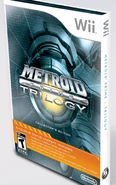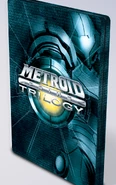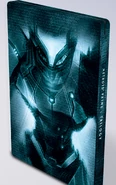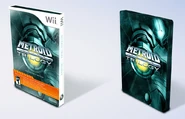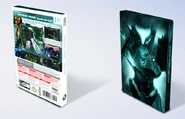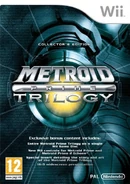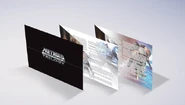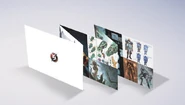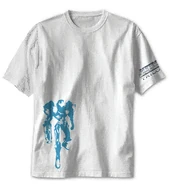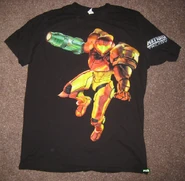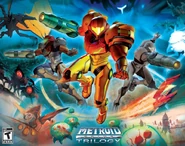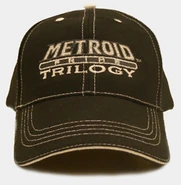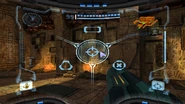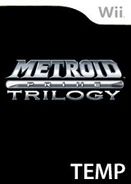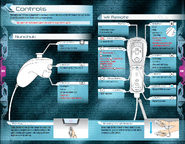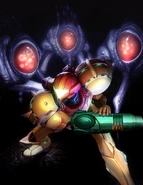| This article is written from the Real Life point of view |
Metroid Prime Trilogy is an enhanced compilation of Metroid Prime, Metroid Prime 2: Echoes, and Metroid Prime 3: Corruption released on August 24, 2009 for the Wii in North America. It was released in the America, Europe and Australia in lieu of New Play Control! versions of the former two. The product has since been discontinued by Nintendo, leading some to believe that the New Play Control! versions of Prime and Echoes would begin to be distributed outside Japan. However, this never happened. In 2013, retailer GameStop obtained additional, unshrinkwrapped copies of the game for release as one of its vintage titles selections.[1]
Additions and changes
Metroid Prime Trilogy includes many of the changes introduced in New Play Control! Metroid Prime and New Play Control! Metroid Prime 2: Dark Echoes, as well as the PAL versions of each individual game. These include, but are not limited to:
- Three difficulty settings: Normal Mode, Veteran Mode, and Hyper Mode, the latter replacing Hard. Normal in the first two Primes is equivalent to the new Veteran. The Normal is an entirely new "easy" mode, and Hyper Mode is the Hard difficulty from both games. All Corruption difficulties remain unaltered.
- Customizable control options similar to Metroid Prime 3: Corruption, which carry over to all three games, but not to multiplayer.
- A Bonus Credits system similar to the one introduced in Corruption, allowing the player to unlock extras such as music or image galleries. This is also how the Fusion Suit is obtained in Prime. The player receives Orange Credits and Purple Credits for defeating bosses in Prime and Echoes, respectively, and Silver Credits for completing certain tasks, like escaping the Frigate Orpheon or collecting a Dark Temple Key.
- Widescreen and 480p support.
- A reworked menu interface with a stylized Arm Cannon interior background, Mii system for game files, files that include all three games (as well as details on location and current power-up status), and connected control options between games on a single Mii file. Individual title screens are removed in favor of this.
- A reworked HUD in Prime and Echoes, it now only displays the current beam/visor in use rather than all obtained, as in the New Play Control! titles. Also, all gauges, the radar, map window, and beam/visor icons become transparent when the cursor passes over them. The Scan Visor has an altered cursor as well, although Sight Windows are still present in Prime.
- The Metroid Prime 2: Echoes Multiplayer returns with Wii controls, but does not support Wi-Fi.
- Doors in Prime and Echoes open faster, although doors in Corruption open much slower.
- Bosses in Echoes are less difficult, in response to common criticism about their difficulty.
- Higher texture quality and resolution is present in Prime and Echoes. Both games now feature bloom lighting as well (which is very noticeable during the Thardus battle in the former game).
- Several altered songs, including those for Flaahgra (fixing the looping issue that was present in the original version of Prime, the theme now plays in full), [1] Luminoth Key, Dark Temple Key, restoring an Energy Controller, Dark Trooper,[2] Bryyo, and Korakk Beast.[3] In addition, a new version of Meta Ridley's theme from the trailer was put in the gallery and the Impact Crater music was added to Echoes.
- The Boost Ball glitch that can be exploited on Meta Ridley has been fixed and is now ineffective.
- In the original version of Corruption, Admiral Dane says "Damn! They're targeting the planetary defense system!" during the briefing scene. In the Trilogy version, the word "Damn" is replaced with "No!" This was also the case with the European version of Corruption.
- Certain special effects from the first Prime were removed due to technical problems. For example, water surfaces no longer ripple in reaction to weapon fire or character movement (although the water will still splash), and the arm cannon is no longer affected by the type of beam it is charging. For example, in the GameCube version, embers would rise from the cannon when charging the Plasma Beam and ice would form over the cannon for the Ice Beam (the sound of this remains, but not the visual). It is commonly believed that the charge effects were incompatible with the many new angles of the arm cannon introduced by the Wii controls. Possible reasons why the water ripples had to be removed are less obvious.
- In Prime, a graphical glitch was introduced on the Arm Cannon when using the X-Ray Visor: Samus's hand inside the cannon is no longer affected by recoil.
- In Prime, the elevator animations used when loading a new area are shown at an incorrect aspect ratio, regardless of widescreen setting.
- In Corruption, there is a data room on the way to Generator B (the only generator Samus does not visit during her first trip to Norion), which has a panel that reveals a code when scanned. Each column provides a hidden message when typed in the Transmission console on Samus's Gunship. The messages were present in the first version of Corruption, but the terminal in the data storage was inactive, and no hints to the messages existed.
- 28413
- 73636
- 55184
- 14758
- Due to the change of certain logs in this version, the logbook was mildly shifted out of order, resulting in certain scans recorded as other things.
- In Corruption, when Samus destroys a Leviathan, it can be seen exploding and collapsing as she leaves it. This was present in the PAL version.
- In Prime, after the Omega Pirate has been defeated, the number of Fission Metroids greatly increases in the mines, as in the PAL version.
- The Omega Pirate can be defeated easily by using Power Bombs.
- In Trilogy version of Corruption, the Piston Hall no longer contains Sky Puffers (seen in the PAL version), and the rotating gate obstruction (seen in the original NTSC version) is replaced by an energy field. This is due to a Secret World in the original game.
- Many of the Sequence Breaking techniques in the games have been fixed in an attempt to discourage Speed Running. This was done at the suggestion of Kensuke Tanabe.
- Attempting to press the Home Button during a cutscene in Prime or Echoes will not bring up the Home Menu. However, this can be done in every cutscene in Corruption.
- In Prime, a female voice saying "Data received" plays after scanning or receiving a hint, as in the PAL version.
Packaging
The packaging of the Trilogy varies between the regions it was released in. In North America, the product came with a metal SteelBook packaging and transparent sleeve. However, in Europe and Australia, the Trilogy instead was packaged in a normal Wii case, but with no text, inside a cardboard sleeve which reproduced the effect of the transparent sleeve and the SteelBook cover and back.
Trilogy also came with a 5 double-sided panel art booklet, featuring concept art from the Prime series, some of which was previously unreleased, along with a history of Samus' adventures through the games. Unfolded, the booklet was just under 36 inches in length.
Content
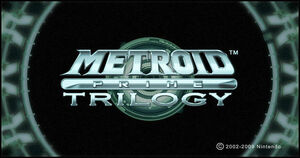
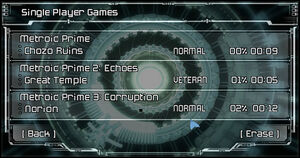
File select screen with tunnel background.
Metroid Prime Trilogy uses a single dual-layered disc to contain the three games of the series. Dual-layering was also used on the discs for Super Smash Bros. Brawl and Metroid: Other M. It allows discs to contain much more content than would be normally available on a standard Wii disc.
The three games are accessed from a special menu that is unique to Metroid Prime Trilogy. The menu has a rotating, mechanical-tunnel background, showing what appears to be the interior of Samus' Arm Cannon. As the player selects the various options and so on, the camera pulls out to various parts of the tunnel. Upon selecting a game file to play, the view pulls back quickly to reveal the outside of Samus' Arm Cannon. A similar tunnel effect can be seen in the intro cutscene in Metroid: Other M.
Trilogy also features several loading screens that play when a certain game is selected by the player. These loading screens feature Samus using the Charge Beam, before turning around and firing a move strikingly similar to the Zero Laser in Brawl. Samus' suit will differ in appearance depending on the progress of the game. In Metroid Prime, the loading screens feature Samus in her Power Suit, Varia Suit, Gravity Suit, Gravity Suit with Grapple Beam and Phazon Suit. Worthy of note is that the Phazon Suit no longer has the Grapple Beam, and the Phazon Beam appears to be configured, as blue veins can be seen running up Samus' right arm. In Metroid Prime 2: Echoes, the loading screens feature Samus in her Varia Suit, Dark Suit, Dark Suit with Gravity Boost and Light Suit. Worthy of note is that there is no Dark Suit with Grapple Beam cutscene. In Metroid Prime 3: Corruption, the loading screens feature Samus in her Varia Suit, Varia Suit with Grapple Lasso and the PED Suit in all of its stages of corruption (with a loading screen for 50% corrupted and Hazard Shield). There is also a separate loading screen for the Metroid Prime 2: Echoes Multiplayer, which shows the four players jumping apart from one another, with the normal Samus firing at the screen. There is no set of loading screens for the Fusion Suit.
Reception
Metroid Prime Trilogy has been mostly well received. However, the removal of graphical effects in the original Prime, as well as Admiral Dane's profanity in Corruption, has received minor fan criticism.[4] Voice actor Timothy Patrick Miller recalled on a minor dialogue alteration for his voice work:
| “ | I realize that video games even more than film is a Director[']s medium. The Director will take any actor[']s performance, edit it, cut it and in general mold it to fit his vision of the overall project. Not only do I not have a problem with that, I don’t see how it can be any other way. Should they find it not to work I expect the voice will be dropped. | „ |
—Timothy Patrick Miller [5] | ||
Trivia
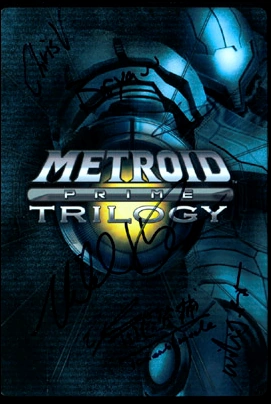
This copy of Trilogy signed by numerous Retro Studios artists was auctioned off on Amazon, with all proceeds being donated to relief efforts for the 2011 Tōhoku earthquake and tsunami.
- "Echoes" was misspelled "Echos" on images released of the box art. [6] This was fixed for the final printing.
- The Trilogy trailer can be viewed on the Nintendo Channel.
- Interestingly, the trailer shows the final bosses in all three games. Also in the trailer, the music that plays while showing clips from each of the games is the respective main theme of the game. The exception are the Corruption scenes, which have the Rundas battle music.
- The theme of the Trilogy can be heard here: [7]
- The first 5,000 Europeans that have previously registered one of the three Prime console titles to also register this game would receive a free download of the original Metroid from the Virtual Console. [8]
- In early 2011, the Metroid Database auctioned off a copy of Trilogy signed by Michael Kelbaugh, Kensuke Tanabe, Bryan Walker, Ryan Powell, Chris Voellmann, Will Bate and Aaron Walker, with 100% of proceeds to be donated to the relief efforts for the 2011 Tōhoku earthquake and tsunami.
- The game's trailer names a Brac Nebula.
Gallery
(Metroid Prime)
(Metroid Prime)
(Metroid Prime 2: Echoes)
External links
- Press release
- Kotaku preview
- IGN preview
- Trailer
- IGN Unboxing
- Spanish Trailer
- GamesRadar Review
- Nintendo Channel trailer
- Nintendo Channel Developer's Voice in HD
- Gallery of merchandise


